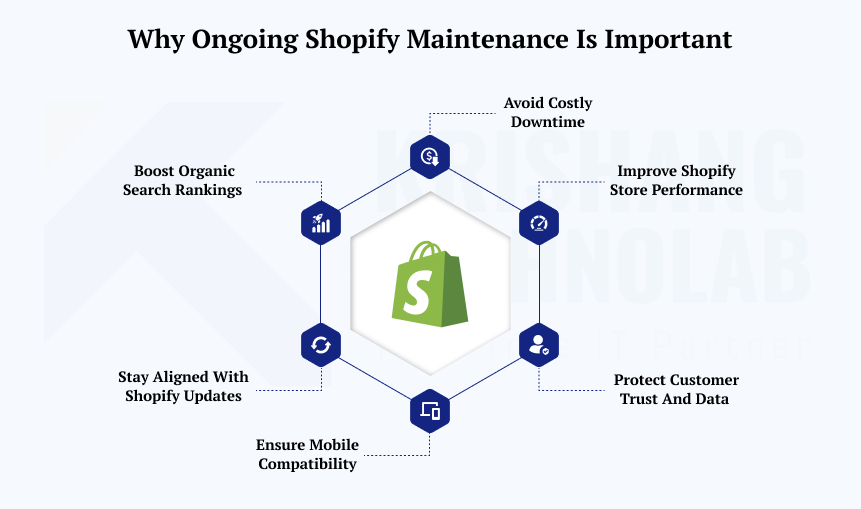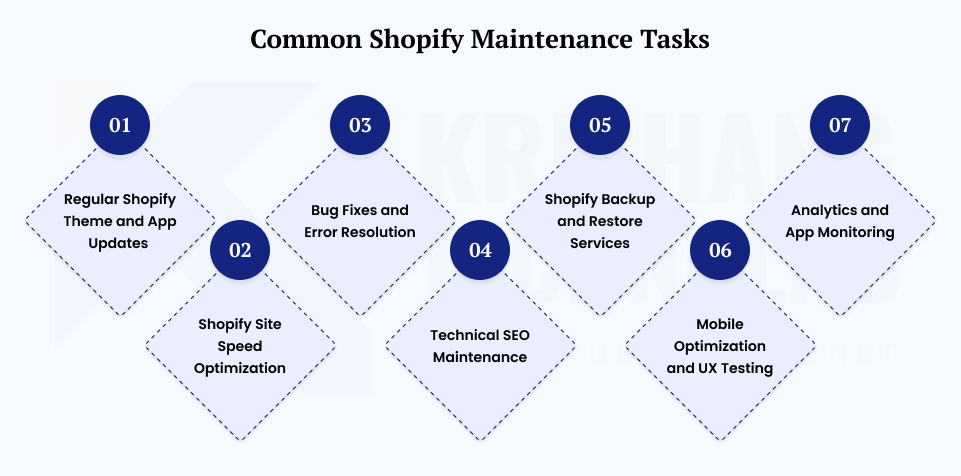
As the owner of an online store, you probably think of your Shopify store as the centre of your sales and success. You have made a shopfront that catches the eye, stocked it with interesting products, started strong marketing, and even gotten some good traffic. You also need the right support and maintenance for your Shopify store to keep it growing.These problems might lower conversions and undermine your brand without you knowing it.
That’s why more and more online stores are hiring a Shopify maintenance service company. You may get theme updates, bug repairs, speed optimization, security monitoring, and frequent backups with the help of an expert. This keeps your store running smoothly 24/7.
This tutorial will teach you what professional Shopify maintenance includes, why it’s important, how to fix common problems, and how to find the best Shopify support agency for your business.
Let’s get started.
What Is Shopify Store Maintenance?
Shopify store maintenance means keeping your store up to date, safe, and running smoothly so that customers have a great shopping experience. Shopify does offer stable hosting and security at the platform level, but your store’s daily functionality and performance depend on regular maintenance, which is usually done by a professional Shopify maintenance service provider.
A lot of store owners think that once their store is open, their work is done. Your store is actually a dynamic ecommerce platform that needs frequent care to be competitive. If you don’t have systematic Shopify store maintenance services, your store could load more slowly, have broken features, old themes, and worse SEO performance, all of which could impact your brand and sales.
Why Ongoing Shopify Maintenance Is Important

1. Avoid Costly Downtime
A single flaw or broken integration can stop your whole checkout process. Regular maintenance keeps problems with your Shopify store from affecting clients.
2. Improve Shopify Store Performance
For SEO and user experience, page speed is very important. You can make your Shopify store run better and lower your bounce rates by doing regular maintenance chores like compressing images, cleaning up apps, and optimising code.
3. Protect Customer Trust and Data
Old themes or programs are often the cause of security holes. Your store is safe from data loss, fraud, and breaches as long as you do frequent backups and security checks.
4. Ensure Mobile Compatibility
More than 70% of online shopping traffic comes from smartphones, so Shopify stores must be mobile-friendly. Check out our detailed guide on Shopify mobile optimization tips to ensure your store performs flawlessly on all devices.
5. Stay Aligned with Shopify Updates
Shopify often adds new features and fixes bugs. Theme or app conflicts can happen if an expert isn’t watching over them. Shopify support and maintenance packages make sure your store works with the most up-to-date platform standards.
6. Boost Organic Search Rankings
If your links are broken, your site is slow, or you have technical SEO problems, your Google ranks could drop. A Shopify site that is well-kept does better in search, which means more visitors and visibility for free.
Common Shopify Maintenance Tasks

It takes more than just one time to keep your Shopify store in good shape. To keep your business running well, safely, and with lots of conversions, you need to do these typical Shopify maintenance activities. Each duty is very important for keeping your store running, enhancing its performance, and making the most money, whether you handle it yourself or hire a Shopify expert for maintenance.
1. Regular Shopify Theme and App Updates
Keeping your apps and theme up to date is one of the most simple but important things you need to do on any Shopify maintenance checklist. Shopify updates its platform constantly, and developers often make changes to themes and apps to offer new features or fix security holes.
- Prevents layout issues and store breakage
- Ensures compatibility with the latest Shopify version
- Reduces the risk of security exploits
Not updating regularly might cause problems with functionality, slow down performance, or even cause the store to crash, especially when there is a lot of traffic or sales.
2. Shopify Site Speed Optimization
Optimising the speed of your Shopify site has a direct effect on your bounce rate, SEO rankings, and sales. Your site could lose conversions every second it takes to load.
- Compressing large image files without losing quality
- Eliminating unused apps or third-party scripts
- Lazy-loading images and videos
- Minifying CSS and JavaScript files
These actions to increase Shopify’s speed make pages load faster, especially on mobile devices, which is where most ecommerce traffic comes from.
3. Bug Fixes and Error Resolution
A single malfunctioning button, graphic glitch, or checkout problem can ruin your users’ experience and cost you money. Any Shopify support service should include regular bug testing and fast problem solving.
- Add-to-cart button not working
- Product variant errors
- Checkout form issues
A Shopify support and maintenance service usually includes monthly or on-demand bug patches to make sure your store runs properly.
4. Technical SEO Maintenance
Your Shopify store might look beautiful, but if it’s not set up for search engines, you’re missing out on free traffic that converts well.
- Fixing links that don’t work (404 errors)
- Fixing broken links (404 errors)
- Optimizing meta titles and product descriptions
- Removing duplicate content
- Improving internal linking and sitemap structure
- Ensuring proper use of canonical tags
Regular audits can help your store stay ahead of changes to search engine algorithms and keep its organic visibility high.
5. Shopify Backup and Restore Services
It’s very important to back up your Shopify store, especially before making changes to the theme, adding apps, or making big upgrades. If something goes wrong, a good Shopify backup and restoration service will make sure that your store’s data, content, and design can be restored.
- Backups that happen every day or week
- Back up by hand before any big upgrade
- Restore points for full or partial recovery
This is important to keep you safe from inadvertent deletions, mistakes when updating, or hackers.
6. Mobile Optimization and UX Testing
More than 70% of online shopping traffic comes from smartphones, thus Shopify stores must be mobile-friendly. Your store needs to work perfectly on all screen sizes.
- Testing navigation, buttons, and layout on mobile
- Ensuring mobile load times are under 3 seconds
- Fixing overlapping elements or touch errors
- Optimizing popups and forms for small screens
A store that works well on mobile devices makes the user experience better and keeps mobile users interested all the way through the funnel.
7. Analytics and App Monitoring
You can’t scale without precise data. To minimise misreporting or gaps in tracking, you need to keep your analytics tools, conversion tracking, and links to third-party apps up to date.
- Verifying Google Analytics, GA4, and Facebook Pixel setup
- Testing conversion events and goals
- Monitoring app updates for tracking conflicts
- Ensuring tracking scripts are firing correctly
This lets you make decisions based on precise, up-to-date performance data.
How Much Does Shopify Maintenance Cost?
Depending on the size, complexity, and support demands of your site, the cost of maintaining Shopify usually ranges from $50 to $1,500 or more per month. Modest stores can get basic Shopify maintenance services for $50 to $150 a month. These packages include updates, backups, and modest repairs. Plans in the middle range for stores that are growing cost $200 to $500 per month and include SEO, speed optimisation, and mobile testing.
Some advanced Shopify support services that include bespoke development and 24/7 monitoring can cost more than $1,000 a month. Pricing is affected by things like how customisable the store is, how often updates are released, and whether you’re on Shopify or Shopify Plus, and the availability of third-party apps. If you hire a Shopify maintenance service, your business will run smoothly, load quickly, and stay safe. This will save you time and money by keeping your store up and running.
Also read about : How much does it cost to hire a Shopify expert?
Need Reliable Shopify Maintenance? Discover Why Krishang Technolab is the Top Choice
When you choose a reliable Shopify maintenance service, you’re not just getting help with problems; you’re also establishing a strong, scalable, and lucrative ecommerce business. What to look for in a top-notch partner, with Krishang Technolab as a great example of what a top-tier partner should give. Here’s what to look for:
- Shopify Expertise
- All-in-One Maintenance
- Fast & Reliable Support
- Scalable Services
- Proactive Strategy
Final Thoughts
Our Shopify store isn’t a one-time setup, it’s a living platform that requires regular updates, security checks, and performance tuning. Skipping maintenance may save time in the short term, but it often leads to costly issues down the line.
By choosing a reliable Shopify maintenance service provider, you ensure your store runs smoothly, loads faster, ranks higher in search engines, and delivers a seamless user experience. From technical upkeep to strategic improvements, the right support partner helps you stay focused on growth while they handle the backend.
Shopify Store Maintenance and Support FAQs
Q: How much does it cost to maintain a Shopify store?
A: Shopify maintenance typically costs between $50 to $500+ per month, depending on your store size and support needs. Hourly rates range from $25 to $100/hour for one-time tasks.
Q: What is Shopify maintenance and why is it important?
A: Shopify maintenance involves regularly updating your store’s theme, apps, speed, security, and SEO. It ensures your site runs smoothly, stays secure, and continues to deliver a great shopping experience.
Q: How often should a Shopify store be maintained?
A: Basic maintenance should be done weekly or monthly. More in-depth tasks like performance audits, SEO checks, and UX improvements are typically done quarterly.
Q: Is ongoing Shopify support necessary after launching a store?
A: Yes. Ongoing support ensures your store stays updated, secure, and optimized helping you avoid bugs, downtime, and missed sales opportunities.
Q: Why choose Shopify store support and maintenance services?
A: Because they ensure your store stays updated, fast, and secure. Professional support helps prevent errors, improve SEO, and boost user experience, freeing up your time to focus on growing your business.
Q: What are the benefits of hiring Shopify support specialists?
A: Shopify experts bring deep platform knowledge, fix issues quickly, handle updates, optimize performance, and provide proactive solutions helping you avoid costly downtime or technical mistakes.
Q: How long should website maintenance take?
A: It normally takes 15 to 60 minutes a week to do basic maintenance on a Shopify website. More complicated duties, such backups, speed optimization, and SEO audits, can take 2 to 4 hours a month. It can take 4 to 8 hours or more for bigger seasonal upgrades. Most of this labor is done well in the background with a professional maintenance plan.
Q: What should be included in a website maintenance plan?
A: A complete website maintenance plan especially for Shopify should include:
- Regular theme and app updates
- Speed and performance optimization
- Bug fixes and error resolution
- Mobile and browser compatibility checks
- SEO monitoring and improvements
- Security scans and malware protection
- Data backups and recovery plans
- Content and product updates
- Analytics tracking and reporting
Q: What happens if a website is not maintained?
A: Without regular maintenance, a website especially a Shopify store can face serious issues such as:
- Slow loading speeds
- Broken features or checkout errors
- Outdated apps or themes
- Security vulnerabilities and hacks
- Poor SEO performance
- Loss of customer trust and revenue
Neglecting maintenance can lead to downtime, reduced traffic, and missed sales opportunities. Regular upkeep helps prevent costly problems and keeps your store running smoothly.